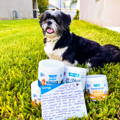My Dog Is Throwing Up Yellow: What Should I Do?
Vet Verified
NOV. 2023 | WRITTEN BY DR. PATRICK MAHANEY
Jump to Section

We all adore our furry friends, and it can be worrying when they're not feeling their best. If your dog has had an upset stomach in the past and you've wondered, "Why is my dog throwing up yellow?" you're not alone. It's a common concern among pet owners––and is a color pet parents often see when their pup throws up.
In this blog, we'll explore the possible reasons behind this unsettling symptom and provide you with some friendly advice on what to do when your beloved pup is under the weather. Your dog's well-being is our top priority, so let's dive in and get to the bottom of this issue together!
My dog is throwing up yellow. What's happening?
A dog vomiting yellow stomach content can be attributed to several factors, with the first and most common being bile. Bile, a digestive fluid produced by the liver and stored in the gallbladder, aids in the breakdown of food.
Sometimes, when a dog's stomach is empty, bile can spill back into the stomach (instead of moving with food into the small intestine to aid in the digestive process) and irritate the stomach lining, resulting in that telltale yellow vomit color. To combat this, consider feeding your pup smaller, more frequent meals throughout the day. More frequent meals promotes gallbladder contraction, helping bile move in the correct direction into the intestines.
However, if your dog is throwing up yellow and exhibits other concerning symptoms, such as lethargy, loss of appetite, bowel movement abnormalities, or abdominal pain, it's essential to consult your veterinarian promptly. These signs could indicate underlying issues like:
- Gastritis (stomach inflammation)
- Pancreatitis (pancreatic inflammation)
- Enteritis (intestinal inflammation)
- Intestinal obstruction (blockage)
- Other digestive-related ailments
In the meantime, ensure your pet remains well-hydrated and withhold food for 12-24 hours to allow their stomach to settle. Gradually reintroduce a bland, easily digestible diet. If the issue persists, don't hesitate to seek professional advice. Our four-legged friends rely on us to be their advocates, so instead of Googling “my dog is throwing up yellow” and hoping for the best, get your vet on the phone for more support.
What is yellow bile, foam, or vomit?
When your dog starts throwing up yellow, it's a worrisome sight that can leave you puzzled. Knowing what the yellow substance is can help you pinpoint the best treatment option for your pup.
So, what's the story behind a dog throwing up yellow bile, foam, or vomit?
To begin, let's uncover the mystery of yellow bile. This digestive fluid, produced by the liver and stored in the gallbladder, plays a crucial role in breaking down food. When a dog's stomach remains empty for an extended period, bile can accumulate, leading to a dog vomiting yellow liquid. It's a sign that their tummy might be protesting, possibly due to irregular feeding schedules or overproduction of bile.
Another substance your dog might cough up is yellow foam. This usually accompanies bile in the vomit, and is a mix of stomach secretions, mucus, and air. It can look frothy and may have a thinner texture than liquid bile.
It's important to distinguish between the occasional instance of a dog throwing up yellow and a recurring pattern. If your canine companion exhibits repeated episodes along with other symptoms like lethargy or loss of appetite, it could be indicative of underlying digestive tract upset, potentially due to one of a variety of causes.
By understanding what lies behind a dog throwing up yellow foam or bile, you can ensure your pet's well-being and provide them with the care they deserve.

Reasons why your dog is throwing up yellow
If you’re wondering “why is my dog vomiting yellow?” after finding a yellow puddle on the floor, there could be a few possibilities.
Your dog has an empty stomach
If yellow vomit happens occasionally, especially in the morning or after a long gap between meals, it may be due to your dog having an empty stomach. Dogs are more prone to this because they have a shorter digestive tract. To mitigate this, try offering smaller, more frequent meals.
Bilious Vomiting Syndrome (BVS)
Bilious vomiting syndrome, or BVS, is caused by a lack of food moving from the stomach into the small intestine, which causes the gallbladder to contract and secret bile into the small intestine. Long fasting periods can make BVS worse, which is why dogs with this condition may vomit yellow bile in the mornings or after fasting before a veterinary procedure.
Food allergies can cause yellow vomit
If your dog threw up yellow, it might be more than an upset stomach––food allergies can also be a culprit behind this unpleasant occurrence. Canines can develop sensitivities to certain ingredients in their diet, leading to digestive distress. If your furry friend constantly vomits yellow, it's worth investigating their food choices with your vet.
A switch to a hypoallergenic or elimination diet could provide relief and help your pet feel better. Hypoallergenic diets are veterinary prescription diets where proteins are modified so that they’re too small to be recognized by the immune system to trigger an allergic response. Food elimination diets involve a novel protein (and/or carbohydrate) that a dog has not regularly eaten, and must be strictly adhered to for around 6 weeks.
Digestion issues or intestinal blockage
Persistent vomiting of yellow fluid could indicate a more serious problem, like an obstruction in the digestive tract. It's essential to consult a veterinarian immediately, as untreated blockages can be life-threatening. Timely intervention and diagnostic tests like radiographs (x-rays), ultrasound, blood, urine, and fecal panels, and more can help identify the underlying cause and ensure your dog's well-being.
exposure to toxins
One of your dog’s greatest bodily defenses is vomiting, which helps the stomach get rid of harmful substances or toxins. It’s one of the potential causes of yellow vomit, and can be triggered by certain chemicals, plants, or medications.
If you suspect toxic ingestion, immediately contact your veterinarian or a veterinary toxicology service, like ASPCA's Animal Poison Control Center at (888) 426-4435 or Pet Poison Helpline at (855) 764-7661. They can provide guidance on treatment and, if necessary, induce vomiting to rid the body of harmful substances. Your vigilance can make all the difference in ensuring your pet's well-being.
What to do when your dog is vomiting yellow bile or foam
Witnessing your dog throwing up yellow bile or foam can be distressing. This peculiar hue is often indicative of an empty stomach, causing bile to irritate the digestive tract. While an occasional episode may not be cause for alarm, recurrent incidents can be a red flag.
Wondering when to contact your vet about dog vomiting? If your dog is frequently expelling yellow bile, it's time to seek professional advice. This might be a sign of an underlying issue like gastritis, pancreatitis, stomach or intestinal blockage, infection, toxic exposure, cancer, or other serious problems.
In the meantime, here's what you can do:
1. Monitor your pet: Keep a close eye on their behavior and any accompanying symptoms. When walking or letting your dog outside, keep them on a short leash to prevent dietary indiscretion (eating something they shouldn’t). Some dogs will attempt to eat environmental materials (grass, leaves, etc.) to induce vomiting, and could accidentally eat something that could cause more issues.
2. Hydration: Ensure your dog stays well-hydrated. Dehydration can worsen the problem by slowing down blood flow to the digestive tract and reducing detoxification of the blood by the kidneys, liver, and other organs.
3. Diet: Temporarily withhold food for 12-24 hours to give their stomach a break.
4. Gradual reintroduction: When you resume feeding, start with a bland diet, like veterinary prescription or home-prepared combinations of easily digestible proteins, carbohydrates, and other nutrients. After 4-7 days (or as directed by your veterinarian, you can gradually transition back to their regular food.
5. Consult your vet: If the issue persists or if you notice other concerning symptoms, it's time to contact your veterinarian for a thorough evaluation and appropriate treatment.
Remember, prompt action can alleviate your furry friend's discomfort and ensure a speedy recovery.
How probiotics can help
Exploring probiotics for dog vomiting can be a game-changer for digestive wellness. Probiotics are beneficial microorganisms that promote a healthy balance of gut bacteria, known as the microbiome. Here's how they can assist in addressing this problem.
Probiotics, when administered appropriately, can help restore balance to the gastrointestinal tract. They boost the population of beneficial bacteria, which can help prevent overproduction of bile, a common culprit behind dog vomiting episodes with that characteristic yellow hue.
Introducing probiotics can be particularly beneficial for dogs experiencing recurrent bouts of vomiting. Just remember to consult your veterinarian before implementing any dietary changes or supplements. They can offer guidance on the right probiotic strain and dosage for your pet's specific needs.
When to visit your veterinarian for yellow vomit
While an occasional episode of dog vomiting may not be cause for alarm, certain scenarios warrant an immediate visit to your veterinarian. If your dog's vomiting is persistent, accompanied by lethargy, loss of appetite, blood in the vomit, bowel abnormalities, or signs of pain, it's time to seek professional guidance. These symptoms can signify underlying issues, demanding a thorough evaluation and tailored treatment from your vet. Timely intervention can make all the difference in ensuring your pet's health and well-being!
Join the Pack!

Sign up for exclusive deals, curated pet tips from veterinarians, and product launches!
Pet Parents are Also Reading
Is My Dog Overweight?
September, 2023
October, 2023
November, 2023
June, 2023
Written By a Vetnique Vet

Dr. Patrick Mahaney, VMD, CVA, CVJ
Dr. Patrick Mahaney works as a concierge-style veterinarian and has a number of celebrity clients through his house-call practice, California Pet Acupuncture and Wellness. He loves building personal, long-term relationships with his clients to best suit their pets’ needs within the comfortable confines of their homes.
To spread his message of holistic veterinary medicine on a large-scale basis, Dr. Mahaney attained a Certified Veterinary Journalist certificate and enjoys contributing to pet-related media projects. He is also a certified veterinary acupuncturist.
Sign up for exclusive deals, curated pet tips from veterinarians, and product launches!























